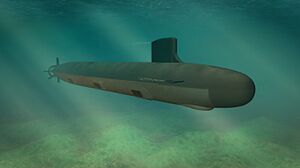Type-64 Attack Submarine: Difference between revisions
ContraViper (talk | contribs) No edit summary |
ContraViper (talk | contribs) |
||
| Line 84: | Line 84: | ||
EEP/S-11 Bow-mounted passive/active sonar... | EEP/S-11 Bow-mounted passive/active sonar... | ||
[INSERT NAME HERE] multimode high-frequency sonar mounted in the sail and lower chin to help detect low-acoustic signature targets such as ROVs and peer submarines, with additional navigation capabilities in shallow waters or complex undersea environments. | [INSERT NAME HERE] multimode high-frequency sonar mounted in the sail and lower chin to help detect low-acoustic signature targets such as ROVs and peer submarines, with additional navigation capabilities in shallow waters or complex undersea environments. | ||
Nifonese-designed WA-38 flank array sonar systems provide side detection of targets, operating in high-frequency, low-probability of intercept mode. | |||
Undersea-to-undersea communications are provided by two systems: the [[SC/UUS-200 Undersea Communicator|SC/UUS-200 "Dolphin's Cry"]] underwater telephone and the ECQ/SC-17A narrow-beam communications sonar. The SC/UUS-200 is a dual-mode system, used for both stealthy short-range (10-20km) and longer-range emergency data transmission with nearby undersea devices, surface buoys or ROVs; while the ECQ/SC-17A uses a narrow-beam low-probably-intercept (LPI) sonar to send simplistic messages at longer distances via "pinging" and "painting" friendly passive equipment, the order of "pings" and "paints" is then deciphered based on the code, in cases of active operations a classified Inyurstan Navy system is used while emergency situations or other miscellaneous scenarios would employ morse code. | |||
20SU2 magnetic signature monitoring & degaussing device is used to keep track of and ideally suppress the submarines magnetic anomaly. while noise monitoring systems alert the crew to how much acoustic disruptions the vessel is causing | |||
===Stealth=== | ===Stealth=== | ||
Coating the outside of the submarine is a mold-in-place anechoic coating. By covering large sections of the hull at once, the coating creates a more uniform smoothness compared to anechoic tiles, thus reducing passive sonar signature while in motion. | Coating the outside of the submarine is a mold-in-place anechoic coating. By covering large sections of the hull at once, the coating creates a more uniform smoothness compared to anechoic tiles, thus reducing passive sonar signature while in motion. | ||
Revision as of 19:10, 13 March 2022
 Type-64 Tíburo Neige SSN
| |
| Class overview | |
|---|---|
| Name: | Type-64 |
| Builders: | Marivál Shipbuilding |
| Operators: |
|
| In commission: | 14 September, 2001 |
| Completed: | 23 |
| Active: | 21 |
| Lost: | 0 |
| Retired: | 2 |
| General characteristics | |
| Type: | Nuclear Attack Submarine |
| Propulsion: | Pump-Jet Propulsor |
| Speed: |
list error: <br /> list (help) |
| Endurance: | Limited only by supplies |
| Sensors and processing systems: |
list error: <br /> list (help)
|
| Armament: |
list error: <br /> list (help) |
The Type-64 Tíburo Neige (English: "Black Shark") is a heavy nuclear fast-attack submarine in service with the Inyurstan Navy. It is designed and operated with the goal of harassing heavily defended enemy naval assets.
Design
Systems
EEP/S-11 Bow-mounted passive/active sonar... [INSERT NAME HERE] multimode high-frequency sonar mounted in the sail and lower chin to help detect low-acoustic signature targets such as ROVs and peer submarines, with additional navigation capabilities in shallow waters or complex undersea environments. Nifonese-designed WA-38 flank array sonar systems provide side detection of targets, operating in high-frequency, low-probability of intercept mode.
Undersea-to-undersea communications are provided by two systems: the SC/UUS-200 "Dolphin's Cry" underwater telephone and the ECQ/SC-17A narrow-beam communications sonar. The SC/UUS-200 is a dual-mode system, used for both stealthy short-range (10-20km) and longer-range emergency data transmission with nearby undersea devices, surface buoys or ROVs; while the ECQ/SC-17A uses a narrow-beam low-probably-intercept (LPI) sonar to send simplistic messages at longer distances via "pinging" and "painting" friendly passive equipment, the order of "pings" and "paints" is then deciphered based on the code, in cases of active operations a classified Inyurstan Navy system is used while emergency situations or other miscellaneous scenarios would employ morse code.
20SU2 magnetic signature monitoring & degaussing device is used to keep track of and ideally suppress the submarines magnetic anomaly. while noise monitoring systems alert the crew to how much acoustic disruptions the vessel is causing
Stealth
Coating the outside of the submarine is a mold-in-place anechoic coating. By covering large sections of the hull at once, the coating creates a more uniform smoothness compared to anechoic tiles, thus reducing passive sonar signature while in motion. Further quiet operation when in motion is achieved through the use of a pump-jet propulsor in place of a traditional rotor. All on-board equipment is seated in ballistic rubber to reduce operating noise. Compared to the smaller Type-60 Attack Submarine, the Tíburo Neige has just below double the built-in electromagnets which serve to offset the vessels electromagnetic signature.
Stealthy weapons launched are achieved via a water ram expulsion system which muffles the sound of non-super-cavitating torpedo launches from the tubes.
Armament
The primary armament of the Tiburo Neige is the Pu-98 Arraia torpedo, an advanced long-range heavyweight torpedo with a variety of attack modes. A last-ditch, short-range option is the Pu-102 Grítonéa Supercavitating Torpedo. Inyurstan for "screamer", the torpedo is an extremely fast weapon which complicates enemy evasive maneuvers and hard-kill defensive systems; though it is extremely limited in range <20km and its launch almost guarantees acoustic detection.
Specially-designed SSU-10 VLS cells carry the SSM-4W Leviathan Anti-Ship Missile, a supersonic sea-skimming anti-ship missile. This addition extends the the range for which the Type-64 can attack enemy surface ships to around 250km, though poses greater risk of revealing their position compared to silently launching torpedoes.